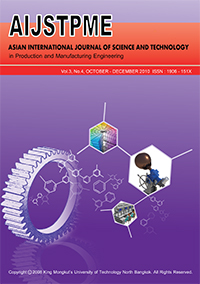Prediction of Weld Quality in Plasma Arc Welding using Statistical Approach
Main Article Content
Abstract
The effect of various process parameters like welding current, torch height and welding speed on front melting width, back melting width and weld reinforcement of Plasma Arc Welding on Aluminum alloy is investigated by using standard statistical tool i.e., Response Surface Method . Variable Polarity Plasma Arc Welding is used for welding Aluminum alloy. Trail experiments are conducted and the limits of the input process parameters are decided. Two levels and three input process parameters are chosen and experiments are conducted as per design matrix. The coefficients are calculated by using regression analysis and the mathematical model is constructed. Analysis of Variance (ANOVA) is carried out to check the adequacy of the developed model. Fisher’s test is conducted for standard tabulated values of F-ratio for a desired level of confidence (say 95%) and found that all the Fisher ratio values calculated for the input process parameters are within the table values and found to be adequate. By using the mathematical model the main and interaction effect of various process parameters on weld quality are studied
Article Details
How to Cite
K., K., Srinivasa Rao, C., & Nageswara Rao, D. (2013). Prediction of Weld Quality in Plasma Arc Welding using Statistical Approach. Applied Science and Engineering Progress, 3(4), 29–35. retrieved from https://ph02.tci-thaijo.org/index.php/ijast/article/view/67388
Issue
Section
Technology


